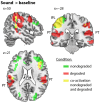Simultaneous EEG-fMRI brain signatures of auditory cue utilization
- PMID: 24926232
- PMCID: PMC4044900
- DOI: 10.3389/fnins.2014.00137
Simultaneous EEG-fMRI brain signatures of auditory cue utilization
Abstract
Optimal utilization of acoustic cues during auditory categorization is a vital skill, particularly when informative cues become occluded or degraded. Consequently, the acoustic environment requires flexible choosing and switching amongst available cues. The present study targets the brain functions underlying such changes in cue utilization. Participants performed a categorization task with immediate feedback on acoustic stimuli from two categories that varied in duration and spectral properties, while we simultaneously recorded Blood Oxygenation Level Dependent (BOLD) responses in fMRI and electroencephalograms (EEGs). In the first half of the experiment, categories could be best discriminated by spectral properties. Halfway through the experiment, spectral degradation rendered the stimulus duration the more informative cue. Behaviorally, degradation decreased the likelihood of utilizing spectral cues. Spectrally degrading the acoustic signal led to increased alpha power compared to nondegraded stimuli. The EEG-informed fMRI analyses revealed that alpha power correlated with BOLD changes in inferior parietal cortex and right posterior superior temporal gyrus (including planum temporale). In both areas, spectral degradation led to a weaker coupling of BOLD response to behavioral utilization of the spectral cue. These data provide converging evidence from behavioral modeling, electrophysiology, and hemodynamics that (a) increased alpha power mediates the inhibition of uninformative (here spectral) stimulus features, and that (b) the parietal attention network supports optimal cue utilization in auditory categorization. The results highlight the complex cortical processing of auditory categorization under realistic listening challenges.
Keywords: alpha suppression; attention; audition; categorization; cue weighting; spectro-temporal information.
Figures




Similar articles
-
Acoustic cue selection and discrimination under degradation: differential contributions of the inferior parietal and posterior temporal cortices.Neuroimage. 2015 Feb 1;106:373-81. doi: 10.1016/j.neuroimage.2014.11.050. Epub 2014 Dec 3. Neuroimage. 2015. PMID: 25481793
-
Thalamic and parietal brain morphology predicts auditory category learning.Neuropsychologia. 2014 Jan;53:75-83. doi: 10.1016/j.neuropsychologia.2013.09.012. Epub 2013 Sep 13. Neuropsychologia. 2014. PMID: 24035788
-
Attention Modulates the Auditory Cortical Processing of Spatial and Category Cues in Naturalistic Auditory Scenes.Front Neurosci. 2016 Jun 7;10:254. doi: 10.3389/fnins.2016.00254. eCollection 2016. Front Neurosci. 2016. PMID: 27375416 Free PMC article.
-
Stimulus-dependent activations and attention-related modulations in the auditory cortex: a meta-analysis of fMRI studies.Hear Res. 2014 Jan;307:29-41. doi: 10.1016/j.heares.2013.08.001. Epub 2013 Aug 11. Hear Res. 2014. PMID: 23938208 Review.
-
Segmental processing in the human auditory dorsal stream.Brain Res. 2008 Jul 18;1220:179-90. doi: 10.1016/j.brainres.2007.11.013. Epub 2007 Nov 17. Brain Res. 2008. PMID: 18096139 Review.
Cited by
-
The Neural Substrates Underlying the Implementation of Phonological Rule in Lexical Tone Production: An fMRI Study of the Tone 3 Sandhi Phenomenon in Mandarin Chinese.PLoS One. 2016 Jul 25;11(7):e0159835. doi: 10.1371/journal.pone.0159835. eCollection 2016. PLoS One. 2016. PMID: 27455078 Free PMC article.
-
Hearing loss impacts neural alpha oscillations under adverse listening conditions.Front Psychol. 2015 Feb 19;6:177. doi: 10.3389/fpsyg.2015.00177. eCollection 2015. Front Psychol. 2015. PMID: 25745410 Free PMC article.
-
Consistent pre-stimulus influences on auditory perception across the lifespan.Neuroimage. 2019 Feb 1;186:22-32. doi: 10.1016/j.neuroimage.2018.10.085. Epub 2018 Nov 2. Neuroimage. 2019. PMID: 30391564 Free PMC article.
-
Neural Processing of Spectral and Durational Changes in Speech and Non-speech Stimuli: An MMN Study With Czech Adults.Front Hum Neurosci. 2021 Aug 9;15:643655. doi: 10.3389/fnhum.2021.643655. eCollection 2021. Front Hum Neurosci. 2021. PMID: 34434094 Free PMC article.
-
Electrophysiology of the Human Superior Temporal Sulcus during Speech Processing.Cereb Cortex. 2021 Jan 5;31(2):1131-1148. doi: 10.1093/cercor/bhaa281. Cereb Cortex. 2021. PMID: 33063098 Free PMC article.
References
-
- Ashburner J., Friston K. J. (2004). “Computational neuroanatomy,” in Human Brain Function, eds Frackowiak R. S., Friston K. J., Frith C. D., Dolan R. J., Price C., Zeki S. (Amsterdam: Academic Press; ), 655–672
-
- Ashburner J., Good C. D. (2003). “Spatial registration of images,” in Qualitative MRI of the Brain: Measuring Changes Caused by Disease, ed Tofts P. (Chichester: John Wiley and Sons; ), 503–531 10.1002/0470869526.ch15 - DOI
LinkOut - more resources
Full Text Sources
Other Literature Sources

